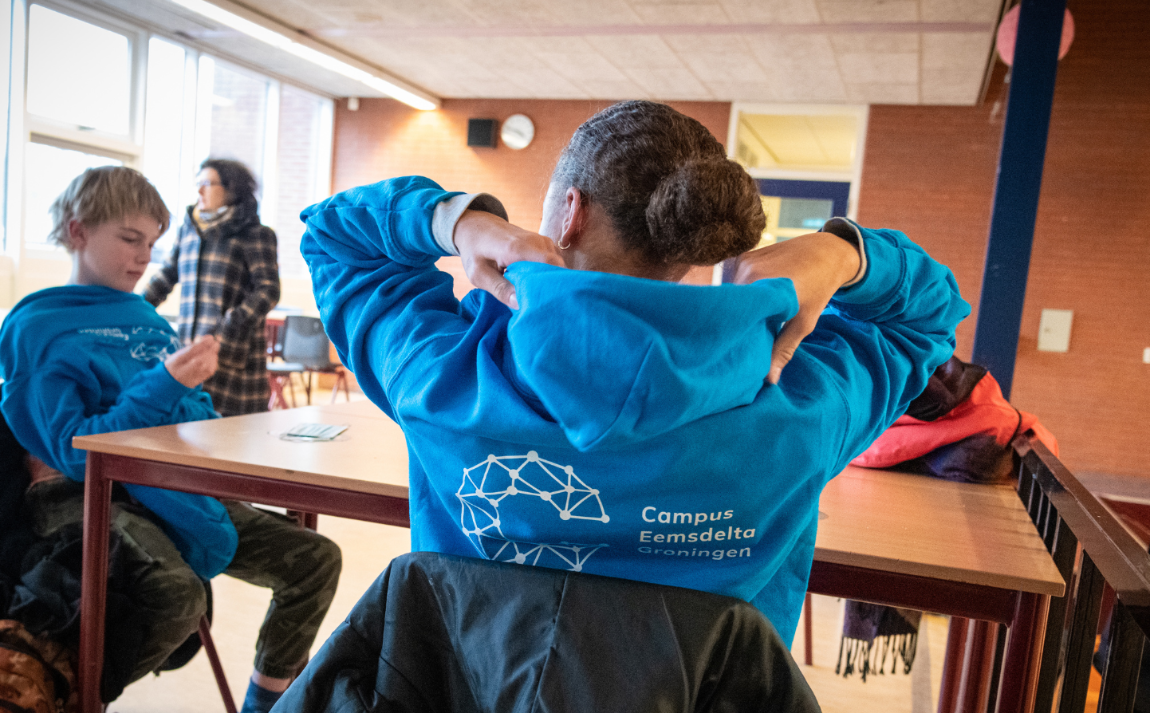- 关于我们
- 数据网络
- 通信基础设施
- 产品
-
资源中心
- 资源中心
- 文件中心
- Blog
-
成功案例
- Overview
- Innoasis development in Norway
- Eemsdelta Campus
- Hotelschool The Hague
- Emergency covid hospital, Hong Kong
- Société du Grand Paris
- Centrin Datacentres
- Airbus
- Athens Historic City Hall
- Pinewood Studios
- Goethe University Frankfurt
- Denmark New University Hospital
- 图卢兹大学
- CHM Maubeuge: a model for future-ready hospitals
- 英文博客
- 软件工具
- 质保
- 新闻及动态
- 查找
- 联系我们
- Compare
- 登录
园区
Fibre To The Office installation for brand new Eemsdelta Campus


The Eemsdelta Campus in Appingedam, the Netherlands, brings secondary education, a practical study programme and a sports cluster together in a single facility. With a total area of 16,600 m2, this new campus consists of several buildings that jointly accommodate 1,700 students. The project, which cost some 38 million euros, was designed from the outset to be extremely energy-efficient, 100% circular and earthquake-proof.
Very high device density
Not many environments feature such a high density of devices as in Education. A classroom might house over 30 students, all with laptops and smartphones, and often also tablets or smartwatches. What’s more, building systems such as lighting controllers and telephones also run on the fibre backbone. On the campus, 5,000 devices could be online at any given moment. Fortunately, the Nexans’ LANactive Fibre To The Office (FTTO) network worked smoothly from day one: from the very first moment, there were 2,000 people on the network, and there hasn’t been a single complaint or failure to date. The network has not been down for even a second - unique for a new building.
The campus was designed to be as energy efficient as possible and utilise an absolute minimum of resources. For this reason, as little copper as possible is used. For the communications network, minimisation of space usage and providing the best possible Wi-Fi were clear objectives, along with low energy consumption.
At the start of the design phase, a consulting firm compared three concepts: a traditional network with ample copper cabling, a GPON network, and an FTTO network. The choice for FTTO was made quickly, partly because it uses 80% less cable than a 'traditional' installation. FTTO proved to perfectly meet all Eemsdelta's requirements regarding space saving, energy consumption, future-readiness, and performance.
LANactive Fibre To The Office
FTTO is an innovative, fibre-based LAN cabling concept. Optical fibre runs from a central switch to a connection point at each workplace. Here, a dedicated Ethernet switch provides intelligent media conversion from fibre to copper. Each FTTO switch is connected to the central distribution switch with one or two SFP uplinks and has four or five user ports, all of which are Gigabit Ethernet capable. The centralised structure of active network components greatly simplifies network deployment, and service, significantly reducing IT infrastructure costs.
In addition, FTTO supports full Power over Ethernet (PoE) functionality. Nexans 8-port, 10G LANactive DICE switch, which can be mounted in ceilings, allows network capacity, bandwidth, as well as PoE power, to be doubled easily in future, with no need for structural modifications.
A fibre-optic 'backbone' runs from the heart of the campus to the various buildings. Because FTTO eliminates the need for separate technical rooms and long, thick copper cables, huge space savings are achieved. 180 centrally managed switches, to which wall outlets and Wi-Fi access points are connected, are linked to four aggregation switches via fibre-optic cables. As there is always a switch nearby, flexibility is significant: with each new device, only a short section of copper cable needs to be installed at the terminal. The campus is connected to a small annex through a P2P connection via the switch. This works just as well as a wired connection - latency is even lower than when using a VPN over fibre. This is all possible because there are active connection points throughout the building, some 800 in total. The network management system always clearly shows which ports are available.
The feature rich switches offer a wide range of options. For example, individual computers can be placed in the network using the switch, based on a username and password. Computers in the exam room, which is shared by several schools, can easily be assigned to a specific part of the network. Interoperability with the other switches on the campus and the rest of the infrastructure is excellent. Furthermore, there is hardly any heat generation - unlike with a traditional network. The configuration of the network and authentication can be closely managed. A basic template for all 180 switches was created based on a Best Practice document from Nexans, and then pushed.
For telephony, the campus now also completely depends on its network. For example, students use an app with a digital lock for lockers. Lighting, CO2 measurements, heating, cooling, the printing and copying system, and payment transactions have been digitised. Antennas everywhere ensure laptops can be used to access education anywhere on and around the campus. Numerous previously disparate systems are now converged and use the same network.
Stimulating innovative thinking
“Due to Covid, we had to organise training through Teams, which was an interesting learning process for me,” explains Georges Kazantzidis, Territory Sales Manager, Nexans, who was closely involved from the beginning of the project until its completion. “It's great to see how this project stimulates innovative thinking among other parties, not only in the field of IT, but also in terms of new materials and processes."
For the VO Eemsdelta Foundation a key advantage of working with Nexans is the direct contact with the support department, explains Casper Bijleveld, ICT Advisor, VO Eemsdelta Foundation, and responsible for ICT infrastructure. "If I have a technical question I receive a clear answer very quickly - I don't need to go through a layer of contacts and resellers first.”
Since the campus opened, many educational institutions, companies and even the Netherlands Chief Government Architect have visited, says Klaas Reinders, Director of Construction & Management, Stichting VO Eemsdelta, responsible for construction of the campus. "The innovative nature of the network is attracting numerous people and has even got major players in the construction world, such as BAM Bouw & Techniek, thinking. People immediately see how unique this project is!"
Categories
我们的网站
选择你的国家查找我们的产品和解决方案
-
Africa
- Africa
- Ghana
- Ivory Coast
- Morocco
- North West Africa
- Americas
- Asia
- Europe
- Oceania
